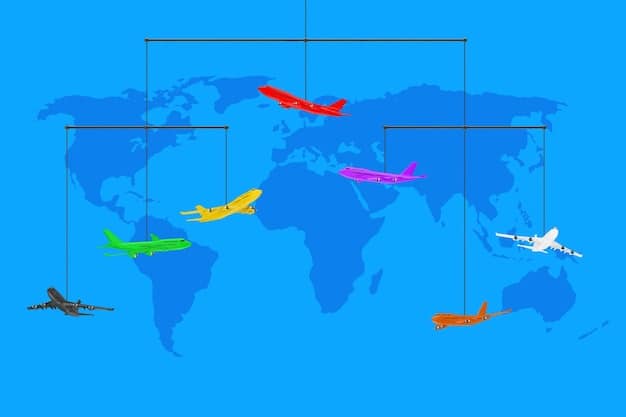Travel Hacking for Beginners: Your Step-by-Step Savings Guide

Anúncios
Travel hacking for beginners involves strategically leveraging loyalty programs, credit card rewards, and unconventional booking methods to significantly reduce the cost of flights, accommodations, and other travel expenses, making aspirational trips more accessible and affordable for everyone.
Anúncios
Embarking on a journey to explore the world doesn’t have to break the bank. For many, the idea of affordable travel seems like a distant dream, but with a strategic approach known as Travel Hacking for Beginners: A Step-by-Step Guide to Saving Money on Travel, it becomes an attainable reality. This guide will demystify the art of travel hacking, offering actionable insights and proven methods to significantly cut down on your travel expenses, turning those dream vacations into concrete plans.
understanding travel hacking fundamentals
Travel hacking isn’t about finding last-minute deals or simply using coupons. It’s a sophisticated strategy that involves understanding and exploiting the nuances of loyalty programs, credit card rewards, and various booking platforms. It’s a game of leveraging systems to your advantage, transforming what might seem like major expenses into minimal costs. This approach requires patience, meticulous planning, and a willingness to learn about the intricate world of points, miles, and promotions.
At its core, travel hacking is akin to a financial optimization strategy, but for your leisure time. It’s about maximizing value, not just minimizing outlay. Beginners often feel overwhelmed by the sheer volume of information available, but breaking it down into manageable steps makes the process less daunting. The ultimate goal is to travel more, experience new cultures, and create lasting memories without the financial burden typically associated with extensive travel.
Anúncios
the mindset of a savvy travel hacker
To succeed in travel hacking, cultivating a specific mindset is crucial. It’s about being proactive and resourceful, always looking for opportunities to earn extra points or save money. This means staying informed about current credit card offers, understanding airline and hotel loyalty programs, and being flexible with your travel plans.
- Be financially responsible: Never spend more than you can afford to pay off to earn points.
- Research diligently: Understand the terms and conditions of every offer.
- Stay organized: Track points, miles, and upcoming deadlines.
- Embrace flexibility: Openness to different travel dates or destinations can unlock significant savings.
This mindset extends beyond simply accumulating points; it encompasses understanding the best ways to redeem them for maximum value. A point or mile’s worth can fluctuate dramatically based on how it’s redeemed, making strategic redemption as important as strategic earning.
debunking common travel hacking myths
Many misconceptions surround travel hacking, often deterring newcomers. One common myth is that it requires a high income or exceptional credit score. While a good credit score is helpful for credit card applications, travel hacking strategies are accessible to a wide range of individuals, regardless of their income bracket. Another myth is that it’s unethical or involves loopholes; in reality, it’s about utilizing legitimate programs as they were designed.
The practice is simply about optimizing rewards based on the rules set by financial institutions and travel providers. It’s not about cheating the system, but rather about understanding and utilizing it effectively for personal benefit. Dispelling these myths is crucial for anyone looking to step into the world of travel hacking without hesitation.
Understanding these fundamentals sets the stage for a successful journey into travel hacking. It’s a marathon, not a sprint, and the rewards—amazing travel experiences at a fraction of the cost—are well worth the initial effort and ongoing dedication.
mastering credit card rewards: your first major step
For most aspiring travel hackers, credit card rewards are the cornerstone of their strategy. These cards offer lucrative sign-up bonuses and ongoing rewards that can quickly accumulate points and miles convertible into free flights, hotel stays, and other travel perks. Choosing the right credit card is paramount, as different cards cater to different spending habits and travel goals.
The key is to understand the various types of rewards programs available. Some cards offer general points that can be transferred to multiple airline or hotel partners, providing flexibility. Others are co-branded with specific airlines or hotel chains, offering direct miles or points within their respective loyalty programs. Each has its advantages depending on your preferred travel style and desired destinations.
choosing the right credit cards for travel hacking
When selecting a credit card, look beyond the initial sign-up bonus. Consider the annual fee (and whether its benefits outweigh the cost), the earning rate on everyday spending categories (e.g., groceries, dining, travel), and any additional perks like free checked bags, airport lounge access, or travel insurance. Always prioritize cards that align with your typical spending patterns to maximize organic point accumulation.
- High sign-up bonus: Aim for cards offering substantial bonuses, often requiring a minimum spend within the first few months.
- Bonus categories: Select cards that offer accelerated earning on categories where you spend the most.
- Transfer partners: Cards with flexible points programs allowing transfers to various airlines and hotels offer greater redemption value.
- Travel benefits: Evaluate perks like no foreign transaction fees, travel insurance, or lounge access.
It’s crucial to apply for cards strategically, usually one or two at a time, to manage minimum spending requirements and protect your credit score. Avoid applying for too many cards in a short period, which could raise red flags with lenders.
strategies for meeting minimum spending requirements
The sign-up bonus is often tied to a minimum spending requirement within a specific timeframe, typically three months. Meeting this requirement responsibly is vital for unlocking the valuable bonus points. The goal is to integrate the spending into your existing budget, not to overspend unnecessarily.
Consider putting all your regular household expenses, such as utility bills, groceries, and dining, on the new card. If you have any large planned purchases, like appliances or home repairs, these can also help meet the threshold. For those who can’t meet the spend naturally, authorized users or paying for group expenses (and having others pay you back) can be an option, but always proceed with caution and clarity.
Never carry a balance on a rewards credit card. The interest charges will quickly negate any value gained from points. The cardinal rule of travel hacking with credit cards is to pay your statement balance in full and on time every month. This protects your credit score and ensures that your “free” travel truly remains free.
By understanding and responsibly utilizing credit card rewards, beginners can rapidly accumulate enough points and miles to cover significant travel expenses, paving the way for memorable adventures with a smaller financial footprint. This is where the real power of travel hacking begins to manifest for you.
maximizing airline loyalty programs and flights

Once you’ve started earning points from credit cards, the next frontier in travel hacking is understanding and maximizing airline loyalty programs. These programs are designed to reward frequent flyers, but savvy travel hackers can leverage them even without constant business travel. The key is to understand how miles are earned and, more importantly, how to redeem them for the best value.
Many airlines are part of global alliances (like Star Alliance, SkyTeam, or Oneworld), which means miles earned on one airline within an alliance can often be redeemed on partner airlines. This significantly expands your redemption options and can unlock flights to destinations you might not have considered. It’s essential to familiarize yourself with these alliances and the specific partners of your preferred airlines.
earning miles beyond flying
While flying is the most direct way to earn airline miles, it’s far from the only method. Credit card sign-up bonuses and everyday spending with co-branded airline cards are powerful tools. Beyond that, many airlines have shopping portals, dining programs, and partnerships with car rental companies or hotel chains where you can earn bonus miles for purchases.
- Shopping portals: Use airline shopping portals for online purchases to earn extra miles per dollar spent at participating retailers.
- Dining programs: Register your credit cards with airline dining programs and earn miles when you eat at participating restaurants.
- Surveys and promotions: Occasionally, airlines offer miles for completing surveys or participating in special promotions with their partners.
- Transfers from flexible points: Convert points from general credit card rewards programs (like Chase Ultimate Rewards or American Express Membership Rewards) to airline miles.
These alternative earning methods are crucial for beginners who may not fly frequently enough to accumulate miles purely through air travel. They allow you to build up your mileage balance passively through everyday activities.
strategic redemption for flights
Redeeming miles effectively can be complex, as award charts and availability vary widely. The golden rule is to aim for redemptions where the cash price of the ticket is significantly higher than the taxes and fees you pay with miles. This often means flying in business or first class, or using miles for expensive international flights where the per-mile value is maximized.
However, economy flights can also be a great deal for shorter routes or when cash prices are unusually high. Always compare the cash price of a ticket versus the miles required plus taxes/fees to determine if it’s a good redemption. Be flexible with your travel dates and destinations, as award availability can be limited, especially for peak seasons.
Using airline miles can transform expensive long-haul flights into incredibly affordable journeys, opening up opportunities for global exploration that would otherwise be out of reach. Mastering this aspect of travel hacking truly elevates the experience beyond simple savings.
optimizing hotel stays and loyalty programs
Just as with airlines, hotel loyalty programs offer immense value for travel hackers aiming to reduce accommodation costs. Major hotel chains like Marriott, Hilton, Hyatt, and IHG all have robust loyalty programs that reward members with points for stays, which can then be redeemed for free nights. Understanding the nuances of these programs, including elite status benefits and strategic redemption, is key to maximizing your savings.
Many hotel chains also offer co-branded credit cards that provide substantial sign-up bonuses, automatic elite status, and free night certificates. These cards can be incredibly valuable for reaching status tiers that offer perks like free breakfast, room upgrades, and late check-out, enhancing your travel experience significantly.
earning hotel points efficiently
Beyond paying for hotel stays, there are numerous ways to accumulate hotel points. Credit card sign-up bonuses are often the quickest way to jumpstart your points balance. Cards co-branded with hotel chains are particularly effective, as they offer category bonuses for spending at their properties and sometimes even annual free night awards.
- Co-branded credit cards: Apply for cards linked to specific hotel chains for large sign-up bonuses and ongoing earning.
- Promotions: Enroll in temporary bonus earning promotions offered by hotel programs, especially during slower seasons.
- Credit card transfers: Convert flexible points from general travel credit cards (e.g., Chase Ultimate Rewards, Amex Membership Rewards) to hotel points.
- Shopping and dining portals: Use hotel-affiliated shopping and dining platforms to earn points on everyday purchases.
For those who travel less frequently, accumulating points through credit card spending and promotions can be a game-changer, providing enough points for several free nights per year without requiring extensive paid stays.
strategic hotel point redemption
The value of hotel points varies by brand and redemption type. Generally, the best value for hotel points comes from redeeming them for higher-category hotels or during peak season when cash rates are high. Look for “sweet spots” in award charts where the points required are disproportionately low compared to the cash price.
Free night certificates, often offered as a perk on co-branded credit cards for hitting spending thresholds or as an annual benefit, can also provide tremendous value, especially when used for expensive nights. Always compare the points cost versus the cash price to ensure you’re getting a good redemption value. Be flexible with your dates if possible, as award availability can fluctuate.
By skillfully accumulating and redeeming hotel points, you can significantly reduce the cost of accommodations, allowing for longer trips or stays in more luxurious properties than traditional budgeting might permit. This aspect is vital for a comprehensive travel hacking strategy.
alternative strategies and advanced tips
While credit cards, airline miles, and hotel points form the bedrock of travel hacking, there are many other innovative strategies that can further reduce travel costs. These alternative approaches often require more creativity and flexibility but can yield significant savings, especially for specific types of travel or destinations.
Consider methods like house sitting, where you provide care for someone’s home and pets in exchange for free accommodation. This not only saves on hotel costs but often provides a more authentic, local experience. Another growing trend is utilizing shared economy services like Airbnb strategically, sometimes even finding places offering long-term discounts that compete with traditional hotels.
leveraging travel portals and booking sites
Don’t overlook the power of online travel agencies (OTAs) and booking aggregators. While direct bookings often come with loyalty points, sometimes OTAs like Expedia, Booking.com, or Kayak offer flash sales or package deals (flight + hotel) that are cheaper than booking separately. Always compare prices across multiple platforms before making a final decision.
- Incognito mode/VPN: Search for flights and hotels in incognito mode or with a VPN set to a different country to sometimes find lower prices due to dynamic pricing.
- Price alerts: Set up price alerts on Google Flights or Skyscanner to be notified when fares drop for desired routes.
- Error fares: Keep an eye out for “error fares” – temporarily mispriced flights or hotels that can offer incredible deals (though these are rare and can be canceled).
- Travel packages: Sometimes, bundling a flight and hotel through an OTA can be cheaper than purchasing them individually, even if you don’t need the hotel for the entire duration.
These tools, when used strategically, can complement your points and miles strategy, providing flexibility and additional savings for those times when award travel isn’t available or doesn’t offer the best value.
manufactured spending and category bonuses
For advanced travel hackers, “manufactured spending” involves using various methods to meet credit card spending requirements without actual purchases. This can include buying gift cards, using payment services for bills that don’t typically allow credit cards, or even buying and reselling items. This strategy requires careful planning and understanding of the risks, as some methods can be shut down by card issuers.
Understanding credit card category bonuses is also crucial. Many cards offer 2x, 3x, or even 5x points on specific spending categories like groceries, gas, dining, or travel. Aligning your spending with these bonus categories can rapidly accelerate your points accumulation without increasing your overall spending. Rotating category cards (like Chase Freedom or Discover It) can offer even higher returns on specific spending each quarter.
While these methods can be highly effective, they demand a higher level of knowledge and responsibility. For beginners, it’s best to stick to organic spending until you’ve mastered the basics and are comfortable with more intricate strategies. Always remember that the goal is budget travel, not budget overspending.
common pitfalls and how to avoid them
While travel hacking offers incredible opportunities for savings, it’s not without its potential pitfalls. Beginners, especially, can fall into traps that negate the benefits of their efforts. Awareness of these common mistakes and learning how to avoid them is just as important as learning the strategies themselves.
The most significant pitfall often involves debt. The golden rule of travel hacking is never to carry a balance on your credit cards. Interest charges quickly outweigh any points or miles earned, turning “free” travel into expensive debt. Always pay your statements in full and on time. This financial discipline is paramount for long-term travel hacking success and credit health.
credit score impact and management
Applying for multiple credit cards, a common practice in travel hacking, can affect your credit score in the short term. Each new application results in a “hard inquiry,” which can temporarily ding your score. Additionally, opening new accounts can lower your average age of accounts, another factor in credit scoring.
However, responsible use—paying bills on time, keeping utilization low—will generally lead to a stronger credit score over time due to a higher total credit limit and a broader credit history. To minimize the negative impact, space out your applications, allow your score to recover, and avoid applying for credit unless you truly need it. Monitor your credit report regularly for any discrepancies.
It’s vital to have a good credit score before seriously embarking on credit card-focused travel hacking. A strong score signals to lenders that you are a responsible borrower, making it easier to get approved for the lucrative rewards cards.
avoiding points and miles expiration
Many points and miles programs have expiration policies. Some expire after a certain period of inactivity (e.g., 18 or 24 months without earning or redeeming activity), while others have a hard expiration date regardless of activity. Losing valuable points and miles due to expiration is a frustrating mistake that’s easily avoidable.
- Regular activity: Make a small purchase on a co-branded card, transfer a few points, or redeem a small amount to keep your account active.
- Track expiration dates: Use spreadsheets or apps to monitor the expiration policies of all your loyalty programs.
- Understand inactivity rules: Know what counts as “activity” for each program (earning, redeeming, or a combination).
- Small redemptions: If points are nearing expiration, consider redeeming them for a small gift card or a less-valuable but accessible redemption to save them.
Staying organized is your best defense against expiration. A proactive approach ensures that the hard work you put into earning those rewards doesn’t go to waste. Always read the terms and conditions of each program carefully to understand their specific policies.
By being mindful of these common pitfalls, beginners can navigate the world of travel hacking more safely and effectively, ensuring that their efforts truly lead to more affordable and enjoyable travel experiences without unforeseen consequences.
planning your first travel hack trip
Once you’ve grasped the fundamentals and started accumulating points and miles, the most exciting part begins: planning your first travel hack trip. This is where theory translates into tangible travel experiences. A successful first trip not only validates your efforts but also provides invaluable learning experiences for future adventures.
Start with a clear goal in mind. Do you want to reduce the cost of a long-haul international flight, enjoy a luxurious weekend getaway, or simply cover the cost of a domestic round trip? Having a specific target helps in focusing your earning and redemption strategies.
setting realistic travel goals
For your initial travel hack, it’s often wise to start small and simple. Don’t aim for a round-the-world trip right away. Perhaps a domestic flight, a short stay at a mid-tier hotel, or a combination of both is a more achievable first goal. This allows you to learn the process without the pressure of a high-stakes redemption.
- Identify target destination(s): Choose a place you genuinely want to visit.
- Determine travel dates: Be flexible, but have a general timeframe in mind.
- Estimate costs: Research typical cash prices for flights and hotels for your desired trip.
- Assess points/miles needed: Check the award charts of your relevant loyalty programs to see how many points or miles you’ll need.
Comparing your current points balances with the requirements will give you a clear roadmap for what you need to earn. It’s a process of setting a goal and then reverse-engineering the steps to get there using your travel hacking tools.
step-by-step trip planning with points and miles
The actual planning process involves several key steps. First, ensure you have enough points or miles for the desired redemption. If not, plan how you’ll earn the remainder, either through credit card bonuses, everyday spending, or flexible point transfers. Always have a backup plan should award space not be available when you need it.
Next, search for award availability. This can be the trickiest part, as popular routes and dates fill up quickly. Be flexible with your dates and consider flying on off-peak days or during shoulder seasons. Use airline and hotel loyalty program websites directly for the most accurate award availability, and be prepared to call customer service if you encounter issues.
Finally, book your travel. Double-check all details, including names, dates, and times, before confirming. Note any taxes and fees you’ll need to pay, as these are typically not covered by points. Once confirmed, track your booking carefully and set reminders for any upcoming deadlines or changes.
Your first successful travel hack trip will be a rewarding experience, solidifying your understanding and confidence in these powerful techniques. It transforms travel from an expense to an accessible adventure, proving that with a little strategy, almost anyone can travel more for less.
| Key Point | Brief Description |
|---|---|
| 💳 Credit Card Rewards | Leverage sign-up bonuses and category spending for points. Always pay balances in full. |
| ✈️ Airline Loyalty | Earn miles beyond flying; redeem strategically for high-value flights, especially business class. |
| 🏨 Hotel Programs | Utilize co-branded cards and promotions for free nights and elite status perks. |
| ⚙️ Avoid Pitfalls | Manage credit score, avoid debt, and prevent points expiration through careful tracking. |
frequently asked questions about travel hacking
While travel hacking can seem complex initially, it’s very accessible for beginners. Starting with simple strategies like credit card sign-up bonuses and focusing on one or two loyalty programs quickly builds foundational knowledge. Patience and a willingness to learn are key, and the benefits of reduced travel costs make the initial effort worthwhile.
A good credit score is highly recommended for obtaining premium travel rewards credit cards, as these offer the most lucrative bonuses. However, you don’t need “excellent” credit to begin. Focusing on improving your score by paying bills on time and keeping utilization low will set you up well for future applications.
The speed of earning depends on your spending habits and the credit card bonuses you pursue. Many beginners can earn enough points for a domestic flight or a few hotel nights within 3-6 months by meeting minimum spending requirements on one or two new credit cards with strong sign-up offers.
The biggest mistake is carrying a credit card balance and paying interest, which voids any savings. Other pitfalls include applying for too many cards too quickly, not understanding points expiration rules, and failing to meet minimum spending requirements for bonuses. Always prioritize responsible financial habits.
While credit card bonuses are the fastest way to accumulate points, you can still travel hack without them. Methods include utilizing shopping portals, dining programs, and leveraging existing loyalty programs. These are slower but still contribute to savings, allowing a more gradual entry into the travel hacking world.
conclusion: unlocking your travel potential
The journey into travel hacking, particularly as a beginner, is an empowering one. It’s an investment of time and strategic thinking that yields incredible dividends in the form of affordable, often luxurious, travel experiences. By understanding the fundamentals of credit card rewards, mastering airline and hotel loyalty programs, and exploring alternative savings strategies, you transform the daunting prospect of travel costs into a manageable, even exciting, challenge. Remember that consistency, organization, and above all, financial discipline are your most potent tools. Embrace the learning process, start small, and watch as your travel aspirations move from distant dreams to tangible reality. The world awaits, and with travel hacking, it’s more accessible than ever before.





